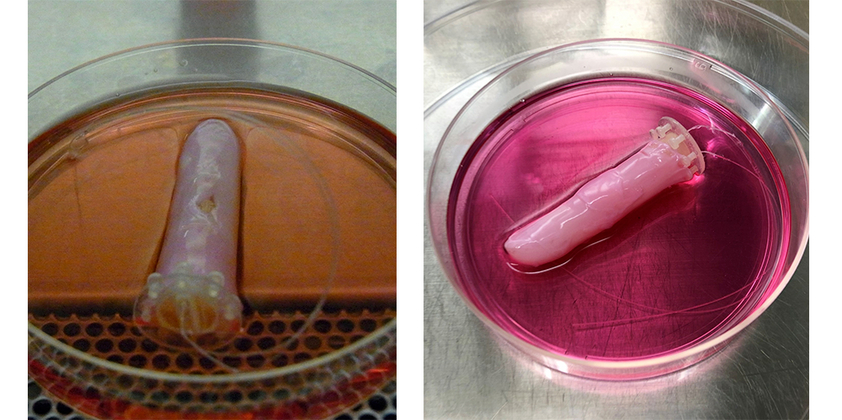J-STORIES ー 人間の細胞から培養した人工皮膚をまとい、傷口の自己修復もできる指型ロボットを日本の研究チームが開発した。シリコン素材を使って人間らしさを出している従来のヒューマノイド(人型ロボット)などとは異なり、培養皮膚をロボットに装着する技術は世界で初めて。将来は生きた肌を持つ義手や義足の実現や再生医療分野での活用などにもつながる可能性がある。
.jpg)
これまでの培養皮膚は平面上に作られてきたが、ロボットのような立体物での実現は新しい取り組みだった。同グループが開発した培養皮膚は、皮膚の表面にある「表皮」とその内側にある「真皮」で構成され、1.5ミリほどの厚さで指型ロボット全体をくるんでいる。
同グループは、真皮細胞が培養の際に激しく収縮する性質を利用して、まず指型ロボット本体をぴったりと覆う真皮組織を作成。その上に表皮細胞を撒いて培養し、真皮と表皮で立体的にロボットを包む人工皮膚を実現した。
人工皮膚を装着した指型ロボットは、皮膚を破損することなく関節を曲げ伸ばしすることができる。曲げ伸ばしの際には人間の皮膚と同じようにシワもでき、表面の撥水性も確認された。
また、メスで作った傷口にコラーゲンシートを貼ると、7日間ほどの培養でコラーゲンシートに真皮細胞が移動し、傷口を自己修復したうえ、修復後も関節運動をすることができたという。

竹内教授は記者会見で、現時点では真皮と表皮だけでできている培養皮膚だが、今後は神経や感覚、血管などもつけ、皮膚としての機能性を高めていきたいと話した。また、筋肉など他の組織と融合することで、より人間らしい動きをするロボットの開発も目指す考えだ。
同教授はこれまで、人工細胞や培養肉の研究の他に、自己修復・増殖するバイオハイブリッドロボットの研究や、生物が匂いや味などを感じる仕組みを利用したバイオハイブリッドセンサーの研究などを行っている。
今回の研究は、人型のロボットの材料としてだけではなく、人工皮膚を装着した人間らしい義手・義足の開発、化粧品や医薬品を検査するための皮膚モデル、動物を犠牲にしない本革製品の実現などに道を開くものと期待されている。
記事:澤田祐衣 編集:北松克朗
トップ写真:twenty20photos / Envato
この記事に関するお問い合わせは、 jstories@pacificbridge.jp にお寄せください。
***
***
本記事の英語版は、こちらからご覧になれます。





_bigthumbnail.jpeg)





![[PODCAST] 外国人創業者が変える日本のスタートアップの形 (Part 7)](https://storage.googleapis.com/jstories-cms.appspot.com/images/1763538829673unnamed_bigthumbnail.jpg)
![[PODCAST] 外国人創業者が変える日本のスタートアップの形 (Part 6)](https://storage.googleapis.com/jstories-cms.appspot.com/images/1763000777388unnamed_bigthumbnail.jpg)







![[PODCAST] 如何打造成功的新創企業社群(第2集)](https://storage.googleapis.com/jstories-cms.appspot.com/images/1748493203370business-man-holding-light-bulb-social-network-2024-10-31-22-37-36-utc_smallthumbnail.jpg)


